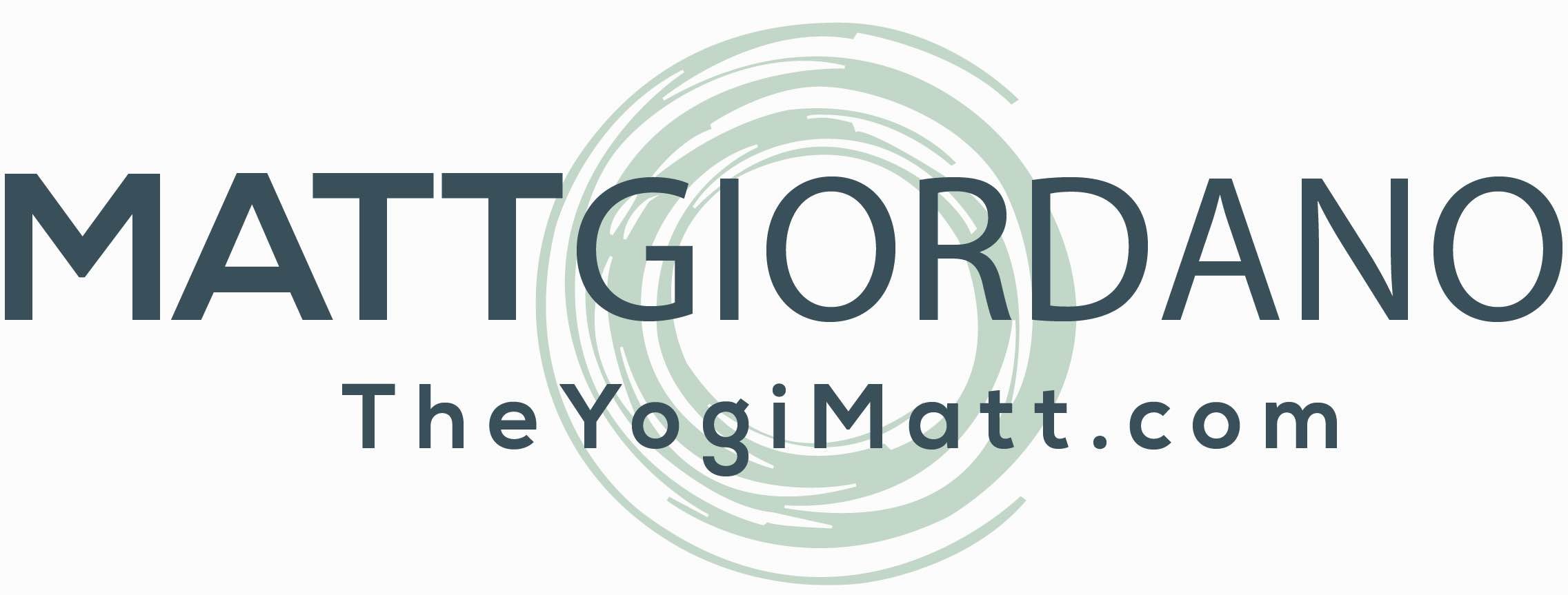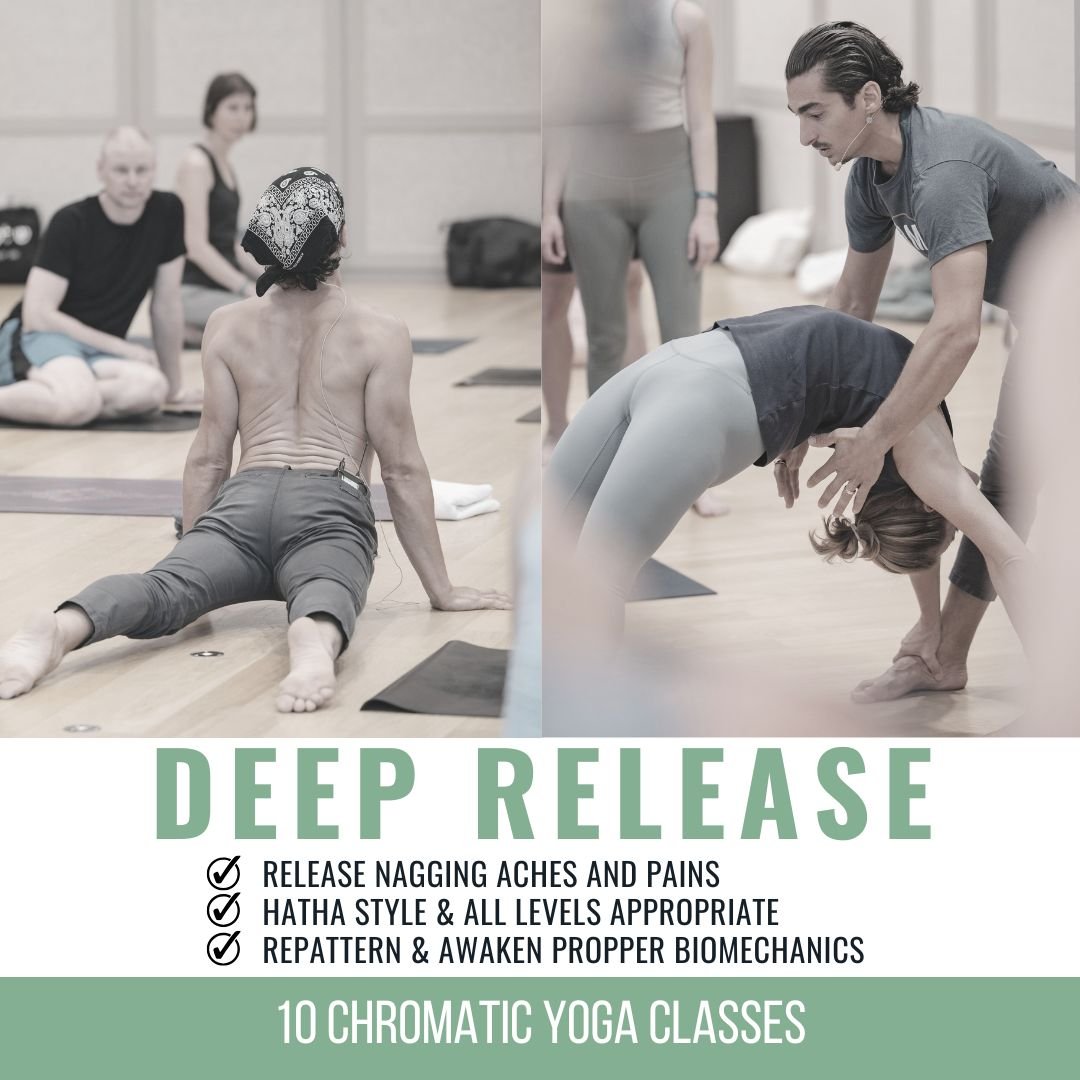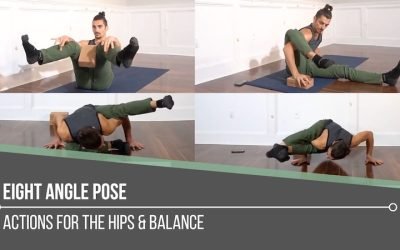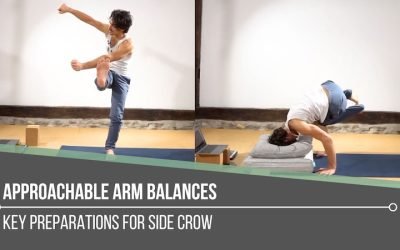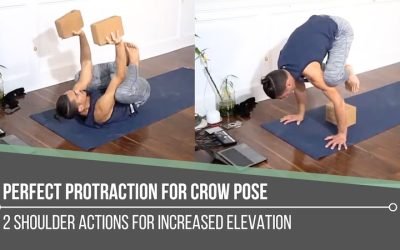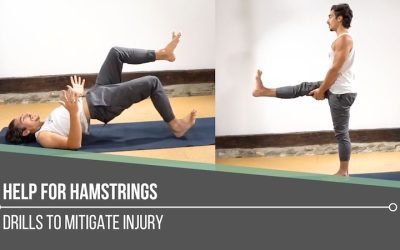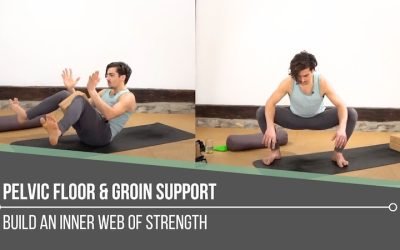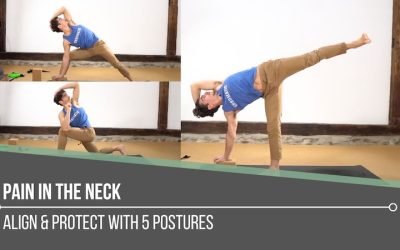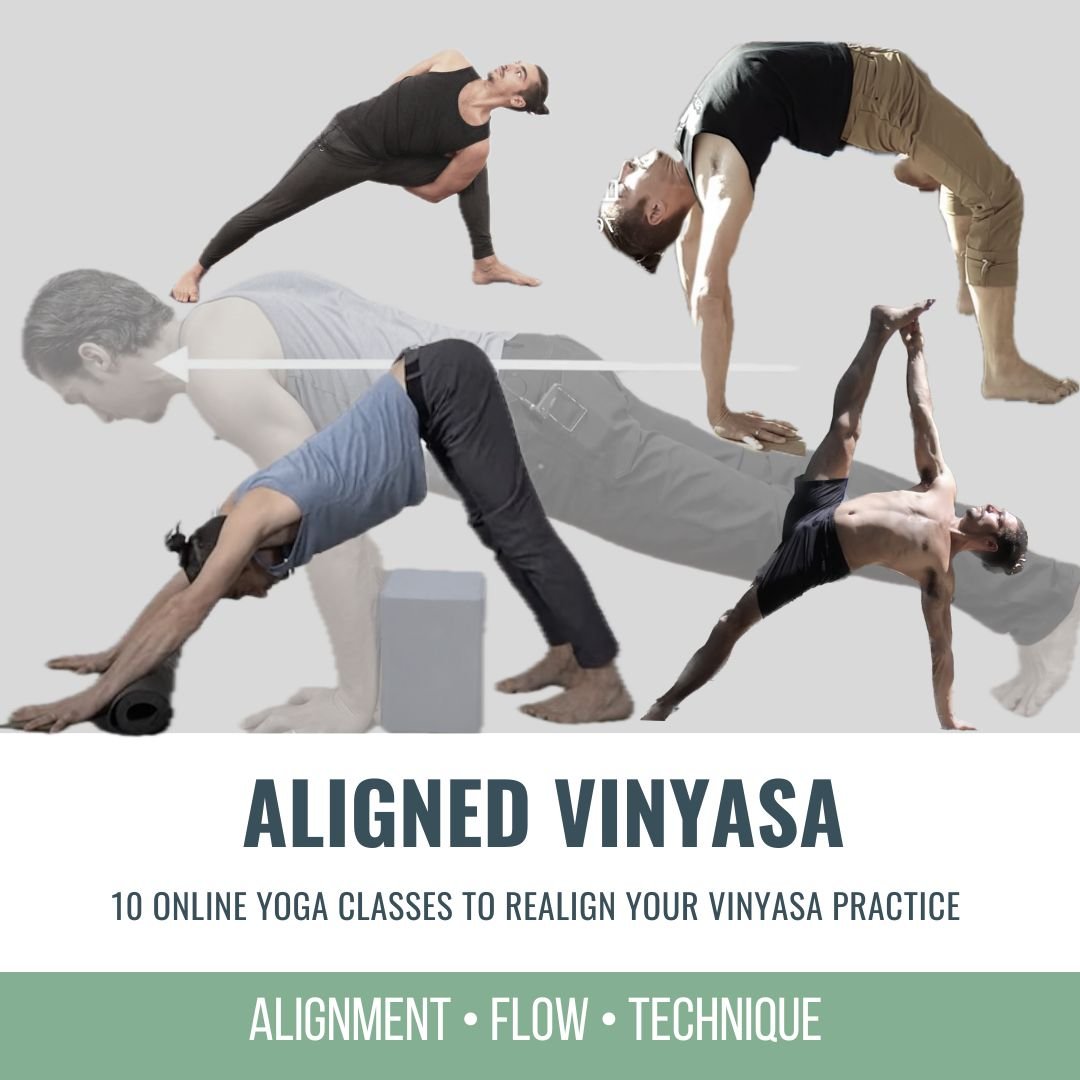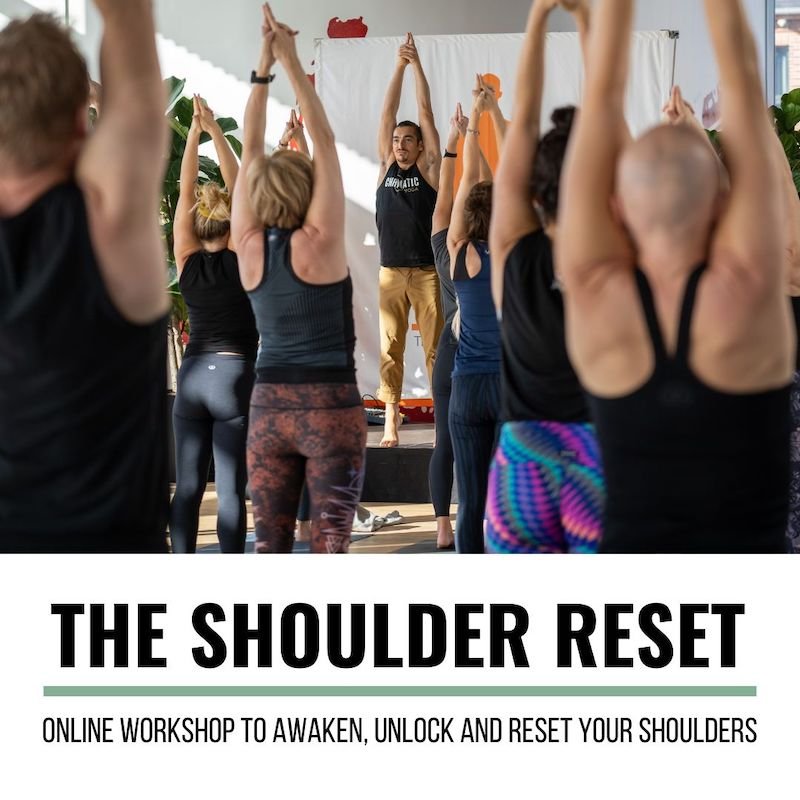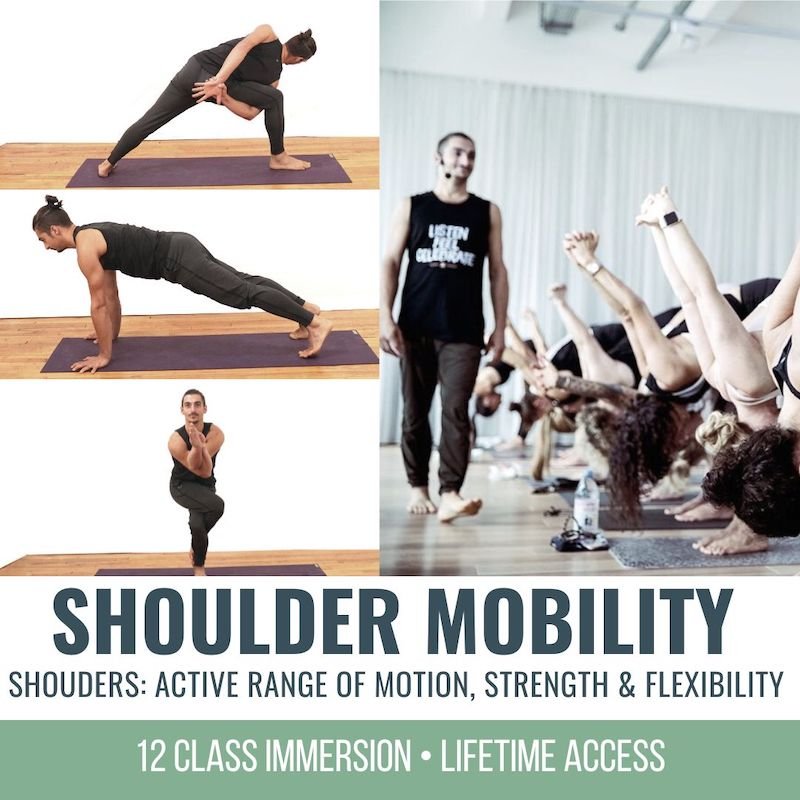Eight Angle PoseASTAVAKRASANAEIGHT ANGLE POSE Sometimes we think arm balances are about getting higher, but Matt reframes Eight Angle pose as a mechanics workshop. This posture thrives when we test rotation, pelvic placement, and upper-body stability as interconnected...
Pain In The Neck
Pain In The Neck
STABILITY
PAIN IN THE NECK
A pain in the neck can be more than just an annoyance. It can ripple into the shoulders, spine, and even the jaw, creating discomfort that affects the whole body. Often, this pain stems from subtle misalignments: a chin that juts forward, a rounded upper back, or a jaw that shifts out of place. These patterns may seem minor, but over time they compound into tension and imbalance. The solution lies in finding what Matt calls the “plumb line,” a neutral head and neck alignment that sets the foundation for healthy posture. By practicing this alignment consistently in key postures, we can support greater stability, reduce strain, and perhaps even prevent future pain in the neck. Consistency is what transforms fleeting relief into lasting results, paving the way for better movement, improved health, and a more easeful yoga practice.
DEEP RELEASE
UNWIND NAGGING ACHES & PAINS
- 10 Chromatic Yoga practices with founder Matt Giordano
- Deep Unwinding of Unwanted Physical Patterns
- Release Most Common Aches and Pains
- Meticulously Crafted Experiences to Enhance Your Postural Practice
- All Levels Appropriate Full length 75 minute Classes
- Non-dogmatic, Anatomy informed Alignment
- The Perfect Blend of Knowledge and Practice
- A Heavy Emphasis on Technique for the Poses Everyone Expects You to Know but Non One Teaches
- 12 Continuing Education hours with Yoga Alliance and American Yoga Council
- 12 Accredited Practice Hours with the Chromatic School of Yoga
- Step-by-Step instruction for increased accessibility
- Sweat, Breath, Strengthen, Stretch and Feel Amazing!
SIDE ANGLE NECK ALIGNMENT
In Side Angle, Matt guides us to rotate the chest without collapsing the shoulder forward. He reminds us that when there is pain in the neck, one of the first places to check is the relationship between ear and shoulder. Rather than letting them collapse together, we lengthen the neck. Options include pulling the chin slightly back or placing a hand behind the head, pressing the head back into the palm to encourage stability. Both shoulders are drawn back so the torso rotates inside the frame of the shoulders rather than dragging the shoulders with it. This mindful rotation helps us cultivate spaciousness and can reduce unnecessary tension in the neck.
WATCH THE VIDEO
PAIN IN THE NECK: ALIGN & PROTECT WITH 5 POSTURES
NECK IN A TWIST
Transitioning into a revolved lunge, Matt places the right elbow to the left thigh and cues us to bring the chin and throat back, keeping the head aligned on its axis. He points out that misalignment here can contribute to pain in the neck and encourages gentle self-adjustments: hand behind the skull, left ear low, right ear long. By pressing through the left heel and pulling the feet toward one another, we create stability through the legs, which frees the neck to rotate with more ease. The focus remains on spaciousness between ear and shoulder while lengthening through the cervical spine. These layers of engagement make the twist strong yet supportive.
200 HOUR ONLINE TEACHER TRAINING
GET CERTIFIED & DEEPEN YOUR YOGA PRACTICE
- Deepen your yoga practice
- Build confidence speaking in front of groups in person and online
- Learn foundational class structures and templates
- Learn techniques for a wide range of yoga postures
- Get certified and highly qualified to teach yoga
- Yoga Alliance Globally Recognized Certification Program
WALL PRESS
With “stop sign” hands, Matt demonstrates another variation to refine awareness. Placing the right hand behind the head, we press the head back to activate opposing muscles while the chest rotates open. He reminds us to keep the back of the neck and occiput long, left ear drawing toward the ground, right ear toward the sky. In doing so, we deepen the twist while reinforcing strength and stability. This careful layering not only enhances mobility but also helps us understand how to work skillfully in positions that often trigger pain in the neck. The focus becomes less about achieving the deepest twist and more about maintaining integrity in the cervical spine.
300 HOUR ONLINE TEACHER TRAINING
GET 500 HOUR CERTIFIED AS A MASTER TEACHER
Master your skill set as a teacher through refined techniques, anatomy, biomechanics, sequencing, philosophy, meditation techniques, theming, yoga business, and much more!
- Get 500 hour certified
- Learn anatomy, biomechanics, asana techniques
- Expand your teaching skills
- Masterful sequencing and verbal delivery
- Learn meditation and breathwork techniques
- Transformative tools: theming, dharma talks, satsang
THE DEPTH OF NECK ROTATION
In deeper twists like Revolved Chair and balancing shapes such as Ardha Chandrasana, Matt emphasizes that success comes from stability and alignment, not from forcing range of motion. In Revolved Chair, he once again offers the option of hand behind the head while pressing back for support, maintaining length through the back of the neck while rotating. In Ardha Chandrasana, he instructs us to align the lifted leg with the torso and shift weight into the big toe of the standing foot, preventing collapse into the pinky edge. From here, placing the hand behind the head can again highlight the need for integrity in the neck. The left ear draws down, right ear lifts up, maintaining a balance of effort and ease. By approaching these postures with patience and precision, we strengthen supportive muscles and learn to move in ways that reduce or even prevent recurring pain in the neck.
Learn about prevention before pain in Matt’s upcoming online immersion called Deep Release this October.
The 200 Hr. Teacher Training: Click Here to See the Next Start Date
The 300 Hr. Advanced Teacher Training: Click Here to See the Next Start Date
Article by Trish Curling
Video Extracted From: Therapeutics Immersion
ONLINE ANATOMY COURSE
- Accessible, exciting, and easy to learn
- Anatomy and biomechanics for yoga
- Appropriate for both teachers and students
- Learn joint alignment vs pose alignment
- Demystify yoga poses and transitions
- Release aches and pains
- Learn how to avoid common injuries
- Caters to all levels with modifications and props
- 20 hours Continued Education Credits with Yoga Alliance
- 20 hours toward Chromatic Yoga Certification and 300 Hour
- Lifetime access
Continue Learning
Eight Angle Pose
Approachable Arm Balances
Approachable Arm BalancesPARSVA BAKASANAAPPROACHABLE ARM BALANCES Approachable arm balances aren’t about fearlessness; they’re about informed action. When we understand the mechanics behind the posture, we gain the power to shape our own outcomes. Rather than jumping...
Perfect Protraction For Crow Pose
Perfect Protraction For Crow PoseBAKASANAPERFECT PROTRACTION FOR CROW POSE When working toward perfect protraction for Crow Pose, it’s essential to understand the role of the serratus anterior, the “fingertip” muscles that wrap around the rib cage and attach to the...
Help For Hamstrings
Help For HamstringsFLEXIBILITYHELP FOR HAMSTRINGS “Yoga butt” or high hamstring tendonitis can be a literal pain where the sit bones meet the hamstrings and glutes. This area is prone to overuse injuries, especially when repetitive forward folds overstretch rather...
Pelvic Floor and Groin Support
Pelvic Floor & Groin SupportCOREPELVIC FLOOR AND GROIN SUPPORT Pelvic floor instability can quietly influence how we move and how safe we feel in our practice. Weakness or imbalance here may lead to groin strains, hip discomfort, or even low-back issues....
Pain In The Neck
Pain In The NeckSTABILITYPAIN IN THE NECK A pain in the neck can be more than just an annoyance. It can ripple into the shoulders, spine, and even the jaw, creating discomfort that affects the whole body. Often, this pain stems from subtle misalignments: a chin that...
THE FREE TECHNIQUE PACK
When You Subscribe, You Will Get Instant Access to
- the Technique Pack: 15 yoga pose breakdowns
- exclusive online course discounts
- exclusive blogs and videos
